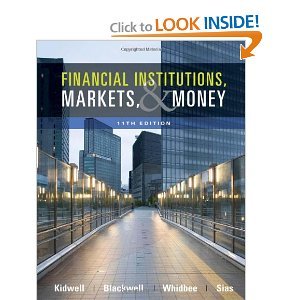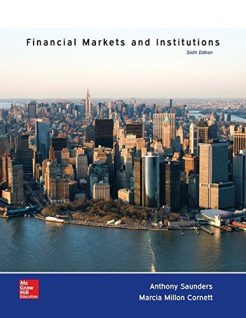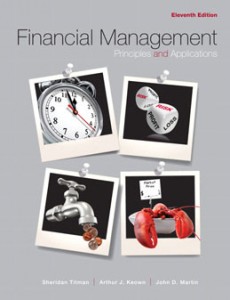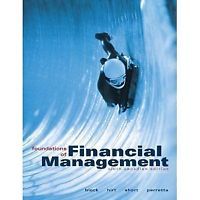Description
solutions manual Financial Institutions, Markets, and Money Kidwell Blackwell Whidbee Sias 11th edition
Delivery is INSTANT. You can download the files IMMEDIATELY once payment is done
If you have any questions, or would like a receive a sample chapter before your purchase, please contact us at inquiry@testbankcorp.com
Table of Contents
Chapter 1 An Overview of Financial Markets and Institutions
Chapter 2 The Federal Reserve and Its Powers
Chapter 3 The Fed and Interest Rates
Chapter 4 The Level of Interest Rates
Chapter 5 Bond Prices and Interest Rate Risk
Chapter 6 The Structure of Interest Rates
Chapter 7 Money Markets
Chapter 8 Bond Markets
Chapter 9 Mortgage Markets
Chapter 10 Equity Markets
Chapter 11 Derivatives Markets
Chapter 12 International Markets
Chapter 13 Commercial Bank Operations
Chapter 14 International Banking
Chapter 15 Regulation of Financial Institutions
Chapter 16 Thrift Institutions and Finance Companies
Chapter 17 Insurance Companies and Pension Fund
Chapter 18 Investment Banking
Chapter 19 Investment Companies
Chapter 20 Risk Management in Financial Institutions
Please note that the files are compressed using the program Winzip.
Files ending with the extension (.pdf) can be opened using Adobe Acrobat Reader.
CHAPTER 1
AN OVERVIEW OF FINANCIAL MARKETS AND INSTITUTIONS
CHAPTER OBJECTIVES
1. This chapter introduces the basic elements of the financial system: financial claims, financial markets, and financial institutions. These elements integrate in a conceptual model of the financial system, shown in Exhibit 1-1. This chapter also develops basic vocabulary, which may not be prudently neglected.
2. The chapter compares and contrasts the two basic kinds of financing relationships—direct finance and financial intermediation—in the context of why financial needs exist, how financial claims arise, and what choices for financial activity emerge in different types of institutions and markets.
3. The chapter compares and contrasts major types of financial institutions and financial markets. These mechanisms—institutions and markets—afford participants more liquidity and diversification. Thus more funds flow to the most productive uses, competition among financial institutions lowers costs, and widespread market participation links prices more closely to information, all of which promote market efficiency. A vigorous financial system promotes economic growth and prosperity by maximizing rational opportunities for investment.
CHANGES FROM THE LAST EDITION
1. Chapter sections are numbered in this edition.
2. Chapter opener has been revised.
3. Tables, exhibits, and data have been updated. Exhibit 1.6 is new to this edition.
4. The set of learning objectives has been revised.
5. “Do You Understand?” questions: (1) in the first set, old Q.4 has been deleted and remaining questions revised, (2) two sets of DYU questions have been deleted and three added. There are now five sets of DYU questions in the chapter.
6. End-of-chapter questions: old Q.8 has been deleted and 11 new questions added (Qs. 8, 11-20).
7. Changes to Section 1.1, “The Financial System”:
– The subsection “A Preview of the Financial System” has been added;
– The subsection “Economic Units” has been eliminated; economic units are now discussed in the next subsection, “Budget Positions”, which has been shortened.
– The subsection “Financial Claims” has been shortened.
8. The sections “Moving Funds from SSUs to DSUs” and “Benefits of Financial Intermediation” have been eliminated. In their place are Section 1.2, “Financial Markets and Direct Financing”, and Section 1.6, “Financial Institutions and Indirect Financing”, that discuss the same material and more. E.g., Section 1.6 discusses asymmetric information, which gives rise to adverse selection and moral hazard issues.
9. The order of sections has been changed: Section 1.2, “Financial Markets and Direct Financing”, is now followed by the sections related to financial markets (“Types of Financial Markets”, “Money Markets”, and “Capital Markets”), and Section 1.6, “Financial Institutions and Indirect Financing”, is followed by the sections discussing types of intermediaries and risks they face.
10. Section 1.3, “Types of Financial Markets”, has a new subsection on public and private markets.
11. Section 1.7, “Types of Financial Intermediaries”, has an expanded discussion of money market mutual funds (MMMFs).
12. The section “Financial Market Efficiency” has been deleted.
13. Section 1.9, “Regulation of the Financial System”, has been added. It covers regulation related to both consumer protection and stabilizing the financial system, as well as provides the highlights of the Restoring American Financial Stability Act of 2010.
14. The feature previously called “Chapter Take-aways” is now called “Summary of Learning Objectives”. The learning objectives from the beginning of each chapter are copied and followed by a short summary of the chapter material related to each objective. This has been done for every chapter.
CHAPTER KEY POINTS
1. The financial system brings savers and borrowers together. Stress these key concepts: SSUs and DSUs, financial claims, direct finance versus financial intermediation, financial institutions, transformation of claims, and types of financial markets. Remind students of financial intermediation in their own lives—checking accounts, insurance, student loans, etc.
2. Direct finance works if preferences of SSUs and DSUs match as to amount, maturity, and risk. Financial intermediaries transform claims to reduce the recurring problem of unmatched preferences:
Denomination Divisibility. DSUs prefer to borrow the full funding need all at once. SSUs tend
to save small amounts periodically. Intermediaries pool small savings into large investments.
Currency Transformation. Intermediaries can buy claims denominated in one currency while issuing claims denominated in another. This would be difficult for most ordinary SSUs.
Maturity Flexibility. DSUs generally prefer longer-term financing. SSUs generally prefer shorter-term investments. Intermediaries can offer different ranges of maturities to both.
Credit Risk Diversification. Intermediaries manage risk by evaluating and holding many different securities. SSUs on their own would have to leave “more eggs in one basket.”
Liquidity. Many claims issued by intermediaries are highly liquid because intermediaries substitute their own liquidity for that of DSUs.
3. Financial institutions are classifiable by their origins, purposes, and major characteristics:
Depository Institutions
Commercial banks
Thrifts (savings and loan associations; mutual savings banks)
Credit unions
Contractual Institutions
Insurance companies (life and casualty)
Private pension funds
State and local government pension funds
Investment Funds
Mutual Funds
Money Market Mutual Funds
Other Institutions
Finance companies
Federal agencies
4. Financial markets are classifiable in a number of concurrent ways:
Primary or Secondary
Public or Private
Exchanges or OTC
Spot, Futures, or Option
Foreign Exchange
International or Domestic
Money or Capital
The respective contributions of money markets and capital markets to the economy are important themes. Representative lists of money and capital market instruments foreshadow chapters covered later in the text.
5. Financial intermediaries are major “information producers” in financial markets. The need for information arises because of asymmetric information – sellers or borrowers in financial transactions usually have more information than buyers or lenders. Asymmetric information is expressed in two ways: adverse selection, which occurs before a financial transaction takes place, and moral hazard, which occurs after the transaction.
6. Risks faced by financial institutions are:
Credit risk
Interest rate risk
Liquidity risk
Foreign exchange risk
Political risk
7. Financial systems need to be regulated for two reasons: consumer protection and stabilization of financial systems.
ANSWERS TO END-OF-CHAPTER QUESTIONS
1. Does it make sense that the typical household is a surplus spending unit (SSU) while the typical business firm is a deficit spending unit (DSU)? Explain.
Households are ultimately SSUs, but have deficit periods when a home or other “big ticket” item is purchased. Businesses usually invest more in real assets than they receive in current operating cash flow.
2. Explain the economic role of brokers, dealers, and investment bankers. How does each make a profit?
Brokers, dealers, and investment bankers make markets at both primary and secondary stages. Funds are raised and claims issued in primary markets with the help of investment bankers, who purchase securities from issuers at one price and sell them to the investing public at a higher price, earning the underwriter’s spread. In secondary markets brokers help bring buyers and sellers of financial claims together, charging commissions, and dealers trade claims in volume, providing liquidity and price discovery and earning the difference between ask and bid price (the bid-ask spread).
3. Why are direct financing transactions more costly or inconvenient than intermediated transactions?
The parties to direct finance have to find each other and negotiate a more or less exact match of preferences as to amount, maturity, and risk. Intermediaries provide all parties choices about financial activity, and drive costs down through competition, diversification, and economies of scale.
4. Explain how you believe economic activity would be affected if we did not have financial markets and institutions.
Financing relationships would arise only when preferences of SSUs and DSUs match. DSUs would not always obtain timely financing for attractive projects and SSUs would under-utilize their savings. The “production possibilities frontier” of the society would be smaller.
5. Explain the concept of financial intermediation. How does the possibility of financial intermediation increase the efficiency of the financial system?
Financial intermediation is the process by which financial institutions mediate unmatched preferences of ultimate borrowers (DSUs) and ultimate lenders (SSUs). Financial intermediaries buy financial claims with one set of characteristics from DSUs, then issue their own liabilities with different characteristics to SSUs. Thus, financial intermediaries “transform” claims to make them more attractive to both DSUs and SSUs. This increases the amount and regularity of participation in the financial system, thus making financial markets more efficient.
6. How do financial intermediaries generate profits?
Intermediaries pay SSUs less than they earn from DSUs. Operating costs absorb part of this margin. Risks taken by the intermediary are rewarded by any remaining profit. Intermediaries enjoy 3 sources of comparative advantage: Economies of scale —large volumes of similar transactions; transaction cost control—finding and negotiating direct investments less expensively; and risk management expertise—bridging the “information gap” about DSUs’ creditworthiness.
7. Explain the differences between the money markets and the capital markets. Which market would General Motors use to finance a new vehicle assembly plant? Why?
Money markets are markets for liquidity, whether borrowed to finance current operations or lent to avoid holding idle cash in the short term. Money markets tend to be wholesale OTC markets made by dealers. Capital markets are where real assets or “capital goods” are permanently financed, and involve a variety of wholesale and retail arrangements, both on organized exchanges and in OTC markets. GM would finance its new plant by issuing bonds or stock in the capital market. Investors would purchase those securities to build wealth over the long term, not to store liquidity. GMAC, the finance company subsidiary of GM, would finance its loan receivables both in the money market (commercial paper) and in the capital market (notes and bonds). GM would use the money market to “store” cash in money market securities, which are generally, safe, liquid, and short-term.
8. What steps should bank management take to manage credit risk in the bank’s loan portfolio?
Banks manage credit risk of their loan portfolios by (1) diversifying the portfolios across regions, industries, and types of loans, (2) conducting a careful credit analysis of potential borrowers, and (3) continually monitoring the borrowers over the life of the loan or investment. Banks develop and follow lending policies which set guidelines for lending officers.
9. Metropolitan Nashville and Davidson County issues $25 million of municipal bonds to finance a new domed stadium for the Tennessee Titans. The bonds have a face value of $10,000 each, are somewhat risky, and mature in 20 years. Enterprise Bank of Nashville buys one of the bonds using funds deposited by Sarah Levien and Ted Hawkins, who each purchased a 6-month, $5,000 certificate of deposit. Explain the intermediation services provided by Enterprise Bank in this transaction. Illustrate with T-accounts.
Metropolitan Nashville and Davidson County Levien ________________________________________ _________________________________
Cash $10,000 from EBN || Bond $10,000 to EBN CD $5,000 at EBN || Cash $5,000 to EBN
Hawkins
_________________________________
CD $5,000 at EBN || Cash $5,000 to EBN
Enterprise Bank of Nashville
___________________________________________________
Bond $10,000 from MNDC || CD Levien $5,000
Cash $5,000 from Levien || CD Hawkins $5,000
Cash $5,000 from Hawkins || Cash $10,000 to MNDC
If Sarah or Ted had $10,000 and wanted to take the risks presented by the bonds, either of them could buy a bond in the direct market from a broker or dealer. Each likely prefers the government guarantee of the CD, the more easily affordable denomination of $5,000, and the ready liquidity (net of some known “penalty for early withdrawal”). Enterprise Bank now has a tax-free source of income from the municipal bond, has made its expert evaluation of credit risk, is diversified with other securities, and can buy the bonds with low transaction costs. Many banks are underwriters of municipal securities and carry inventories as dealers. The City of Nashville has financed a capital project (the stadium) by issuing financial claims (the bonds). The bank bought a bond with deposit funds it raised by issuing Sarah and Ted CDs, which are assets to them and liabilities to the Bank. The bond and the CDs are separate claims varying in denomination, maturity, risk, and liquidity. The bank takes a position of risk, keeps part of the interest income from the bonds as a reward for that risk, and distributes part of it to Sarah and Ted to reward them for postponing current consumption. The city, the ultimate borrower or DSU, has no direct relationship with Sarah and Ted, the ultimate lenders or SSUs.
10. Explain the statement, “A financial claim is someone’s asset and someone else’s liability.”
There are always two sides to debt. To the issuer of the debt, it is a liability. To the holder of the debt, it is an asset. A financial asset always appears on two balance sheets; a real asset on just one.
11. Why are banks singled out for special attention in the financial system?
Banks are the dominant type of depository institutions. As such, they deal with consumers (depositors), and consumers’ trust in the banking system is extremely important for the flow of funds and ultimately the well-being of the economy. Also, banks, like other depositories, are highly leveraged (liabilities are often around 90% of total assets, with capital being the other 10%), which makes them much more vulnerable to credit and liquidity risks than other businesses.
12. Explain why households are the principal SSUs in the economy.
Households in the U.S. are more likely to have their income exceed their expenditures than businesses, which either look to expand and thus are DSUs or pay out the extra cash to shareholders in the form of dividends or share repurchases, or governments, which are often plagued by political agendas and run deficits.
13. Explain why direct financial markets are wholesale markets. How do consumers gain access to these important markets?
Direct financial markets are dominated by institutions that want to avoid the costs of registering securities with the SEC and transact large amounts of securities between each other. Only wealthy individuals, so called “accredited investors” (one must have high income and/or net worth to be considered an accredited investor) may participate in direct financial transactions such as private placements.
Small individual investors access financial markets indirectly through intermediaries such as commercial banks or mutual funds.
14. What are money center banks and why were they not allowed to engage in investment banking activities following the Great Depression?
Money center banks are large commercial banks located in major financial centers. The Glass-Steagall Act of 1933 separated commercial banking and investment banking because it was believed that excessive risk taking by commercial banks resulted in large number of bank failures after the 1929 stock crash followed by a depression. Commercial banks were again allowed in investment banking activities (and vice versa) in 1999.
15. What is the difference between marketability and liquidity?
Marketability is the ease with which a security can be sold and converted into cash. Liquidity is the ability to convert an asset into cash quickly without a loss of value. While the two concepts are similar, marketability does not carry the implication that the security’s value is preserved.
16. Municipal bonds are attractive to what type of investors?
Municipal bonds are long-term debt of state and local governments. Their coupon income is exempt from federal income tax. Therefore, they are attractive to individuals and businesses in high income tax brackets.
17. Why do corporations issue commercial paper?
Commercial paper is short-term corporate debt; it is issued to meet corporate short-term cash obligations.
18. Explain what is meant by moral hazard. What problems does it present when a bank makes a loan?
When it comes to loans, moral hazard occurs if borrowers engage in activities that increase the probability of default. A firm that has taken a bank loan may take on very risky investment projects which, if successful, would result in large profits, but which have high probabilities of failure. The reason for such behavior is that lenders do not share the upside with shareholders of the firm. To reduce moral hazard, the bank may impose some restrictions on the borrower stipulated in the loan contract (e.g., to maintain certain financial ratios at a certain level or better, to not acquire certain assets, or to reduce expenses), and continually monitor the borrower.
19. Explain the adverse selection problem. How can lenders reduce its effect?
Adverse selection arises from asymmetric information and, in the context of debt markets, refers to borrowers of poor credit quality applying for loans (perhaps because such borrowers need the loans the most in order to survive financially). The lender may reduce adverse selection by requiring loan applicants to supply detailed financial statements and other additional information, to use differential loan pricing for borrowers of different credit quality, or to reject loan applications if the risk appears too high. To process the information they collect, lenders often develop or acquire from third party credit scoring models that help determine borrowers’ creditworthiness.
20. Why is the financial system so highly regulated?
The regulation is needed to protect consumers from abuses by unscrupulous financial firms and to ensure economic stability. People should have confidence in the financial system for it to function well, and a well-functioning financial system is critical for ensuring the flow of funds and, in turn, economic growth.







Reviews
There are no reviews yet.